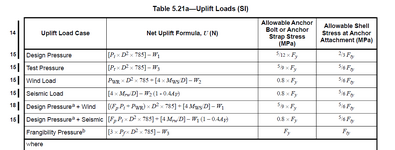Recently I have been reading PIP 03020. I will post some threads to clear my inquiries.
I am sorry that I posted this thread in "Civil General Discussion" Part. But I don't know how to delete that thread. Following are my questions.
1. Code mentioned, for load combination about hydrotest, soil bearing capacity is allowed to be increased by geotechnical engineer, will this be written in geotechnical report?
Or for more common wind load cases, will geotechnical report indicate increase for SBC?
2. Code mentioned that for uplift check, weight of product over foundation could be considered "in the case of seismic load". Does it mean for load cases without seismic load, product weight shall not be considered to resist uplift?
3. Code mentioned anchor bolts shall be placed inside outer face of hoop steel? Why is it required to be mentioned? I think there is enough distance between anchor bolts and hoop steel.
4. Code mentioned that in case depth of ring wall is smaller than its width, ring wall's behavior as an annular slab shall be considered, is there any proportion for beam design, that is, ratio of h to b, when this effect shall be considered?
I am sorry that I posted this thread in "Civil General Discussion" Part. But I don't know how to delete that thread. Following are my questions.
1. Code mentioned, for load combination about hydrotest, soil bearing capacity is allowed to be increased by geotechnical engineer, will this be written in geotechnical report?
Or for more common wind load cases, will geotechnical report indicate increase for SBC?
2. Code mentioned that for uplift check, weight of product over foundation could be considered "in the case of seismic load". Does it mean for load cases without seismic load, product weight shall not be considered to resist uplift?
3. Code mentioned anchor bolts shall be placed inside outer face of hoop steel? Why is it required to be mentioned? I think there is enough distance between anchor bolts and hoop steel.
4. Code mentioned that in case depth of ring wall is smaller than its width, ring wall's behavior as an annular slab shall be considered, is there any proportion for beam design, that is, ratio of h to b, when this effect shall be considered?

